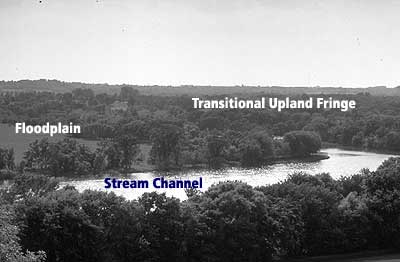 |
 |
RIVER SYSTEM FUNCTIONS: A RIVER SCIENCES PRIMER
INTRODUCTION
Many factors, including physical, climatic, chemical and biological conditions, determine how a river functions. Understanding a river system involves understanding the complex interactions of these factors. This chapter provides an overview of the principal components of river systems. The discussion focuses initially on the basic components of a cross-section of the river system including the stream channel, the floodplain, and the transitional upland fringe. The discussion then focuses on how characteristics of a river system change from its headwaters to its mouth. Particular attention is given to identifying longitudinal changes in watershed functions, channel formation and other characteristics. The next section examines stream processes, such as hydrologic, hydraulic, geomorphic, and physical and chemical processes, and the last section discusses other important features of stream corridors, such as biological communities and system equilibrium.
BASIC PHYSICAL COMPONENTS OF THE STREAM CORRIDOR: A CROSS-SECTIONAL VIEW
Before examining the dynamic interactions of flowing water in the stream corridor, it is important to understand the basic structural components of the corridor itself. This section identifies the key structural components of the stream corridor cross-sectionally. Most stream corridors contain three main components: the stream channel, the floodplain and the transitional upland fringe (Figure 1.1). The stream channel contains flowing water for at least a portion of the year. The floodplain, the land adjacent to stream channel, receives floodwaters and concomitant sediment when the stream channel overflows. The nature and size of floodplain vary both along river systems and between river systems. Depending on the surrounding topography, the floodplain may include land on one or both sides of the channel, and the area may vary considerably along a river. The transitional upland fringe is defined as the upland area on one or both sides of the floodplain that delineates the floodplain from the surrounding landscape.
Stream Channel
Flowing water and the sediment it carries form, maintain and modifie the stream channel. Although the form of a stream channels can vary greatly, from meandering gentle streams to fast flowing rivers, it tends to take on a rounded u-shape. When scientists study a stream cross-sectionally, they invariably examine two key attributes of the system — stream flow and channel size. Stream flow is the volume and velocity of water entering the channel. Precipitation is the original source of all stream flow; the pathways it takes after falling to the earth affect the quantity, quality and timing of the stream flow. The two basic flow pathways are storm flow and base flow. Storm flow is precipitation that reaches the channel very soon after precipitation via overland or underground routes. Base flow is precipitation that percolates to the ground water and moves slowly through the substrate before reaching the channel. Base flow provides stream flow during periods of little or no precipitation. The measure of stream flow used by those studying river systems is known as the discharge rate, which is the volume of water moving down the channel per unit of time. It is measured in cubic feet per second (cfs) in the U.S. Discharge rates depend both on the average velocity at which the water is moving downstream and the size of the channel through which the water is flowing.
Channel size is determined by stream flow and sediment load. Sediment load refers both to the amount of sediment the stream is transporting and depositing and to its characteristics. These characteristics are described in more detail below. A stream balance equation formally describes the dynamic relationship between channel size and sediment load and stream flow. This equation states that the channel is in equilibrium when the sediment load is balanced with stream flow. If changes in either sediment load or stream flow occur, the balance will be lost temporarily. These changes will modify the channel over time, by either building up or scouring the riverbed, to bring the system back into equilibrium. The stream balance equation is useful for conceptualizing the potential impacts on a channel resulting from changes in runoff or sediment loads from the watershed.

Figure 1.1 The Major Cross-Sectional Components of the Stream Corridor. Photo courtesy of the University of Minnesota Extension Service